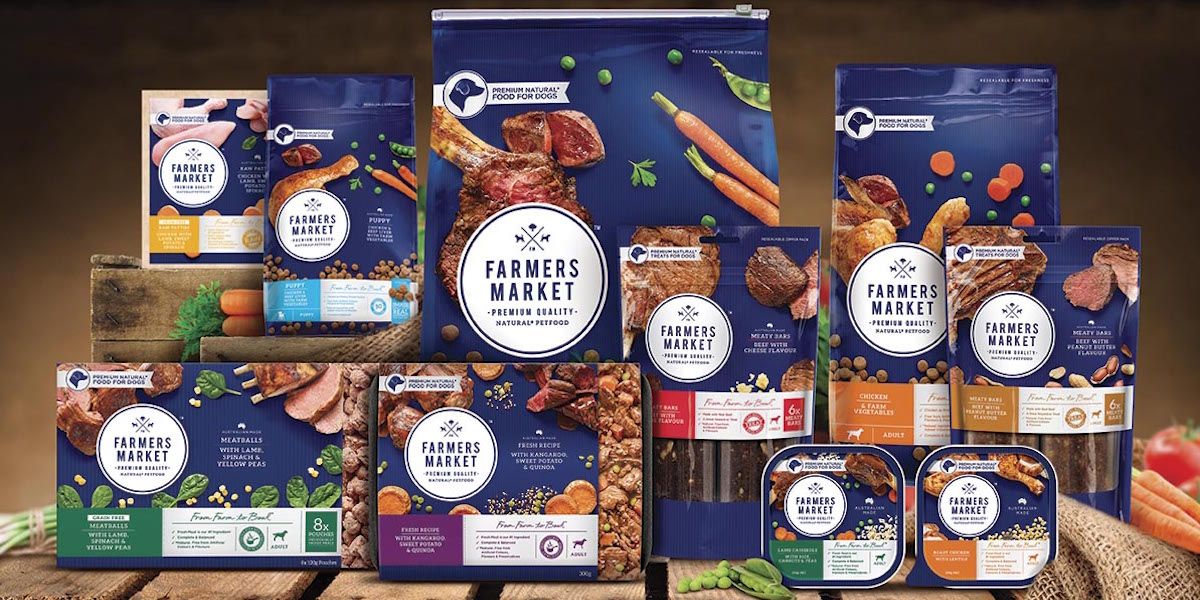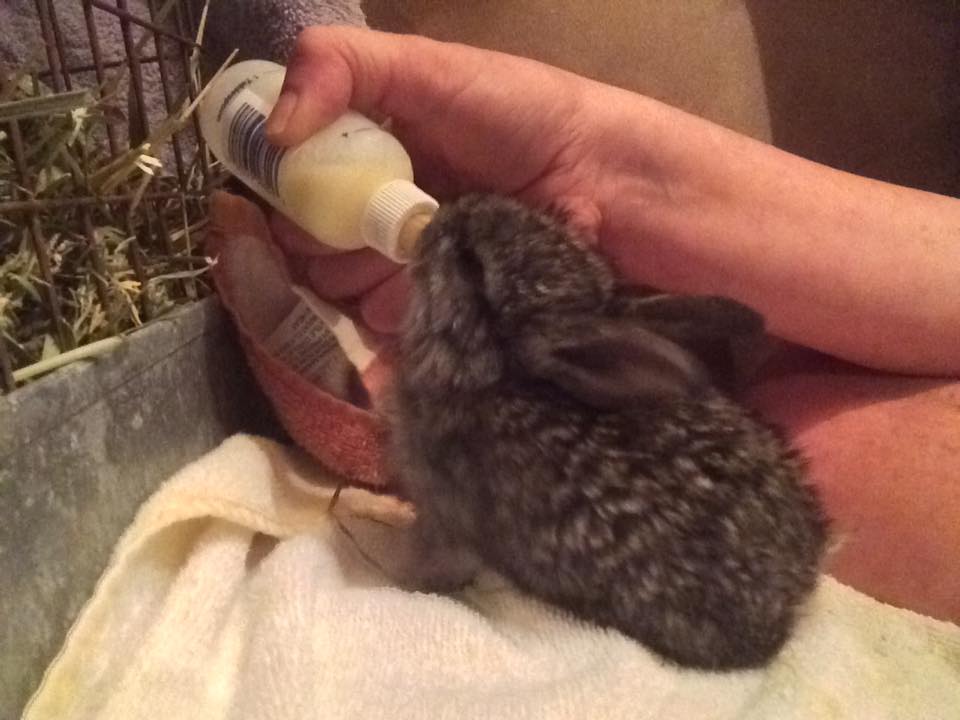6 month old baby food diet
Feeding your baby: 6–12 months
At 6 months of age, breastmilk continues to be a vital source of nutrition; but it’s not enough by itself. You need to now introduce your baby to solid food, in addition to breastmilk, to keep up with her growing needs.
Be sure you give your baby her first foods after she has breastfed, or between nursing sessions, so that your baby continues to breastfeed as much as possible.
When you start to feed your baby solid food, take extra care that she doesn’t become sick. As she crawls about and explores, germs can spread from her hands to her mouth. Protect your baby from getting sick by washing your and her hands with soap before preparing food and before every feeding.
Your baby's first foods
When your baby is 6 months old, she is just learning to chew. Her first foods need to be soft so they’re very easy to swallow, such as porridge or well mashed fruits and vegetables. Did you know that when porridge is too watery, it doesn't have as many nutrients? To make it more nutritious, cook it until it’s thick enough not to run off the spoon.
Feed your baby when you see her give signs that she's hungry – such as putting her hands to her mouth. After washing hands, start by giving your baby just two to three spoonfuls of soft food, twice a day. At this age, her stomach is small so she can only eat small amounts at each meal.
The taste of a new food may surprise your baby. Give her time to get used to these new foods and flavours. Be patient and don’t force your baby to eat. Watch for signs that she is full and stop feeding her then.
As your baby grows, her stomach also grows and she can eat more food with each meal.
Feeding your baby: 6–8 months old
From 6–8 months old, feed your baby half a cup of soft food two to three times a day. Your baby can eat anything except honey, which she shouldn't eat until she is a year old. You can start to add a healthy snack, like mashed fruit, between meals. As your baby gets increasing amounts of solid foods, she should continue to get the same amount of breastmilk.
Feeding your baby: 9–11 months old
From 9–11 months old, your baby can take half a cup of food three to four times a day, plus a healthy snack. Now you can start to chop up soft food into small pieces instead of mashing it. Your baby may even start to eat food herself with her fingers. Continue to breastfeed whenever your baby is hungry.
Each meal needs to be both easy for your baby to eat and packed with nutrition. Make every bite count.
Foods need to be rich in energy and nutrients. In addition to grains and potatoes, be sure your baby has vegetables and fruits, legumes and seeds, a little energy-rich oil or fat, and – especially – animal foods (dairy, eggs, meat, fish and poultry) every day. Eating a variety of foods every day gives your baby the best chance of getting all the nutrients he needs.
If your baby refuses a new food or spits it out, don’t force it. Try again a few days later. You can also try mixing it with another food that your baby likes or squeezing a little breastmilk on top.
Feeding non-breastfed babies
If you're not breastfeeding your baby, she’ll need to eat more often. She'll also need to rely on other foods, including milk products, to get all the nutrition her body needs.
- Start to give your baby solid foods at 6 months of age, just as a breastfed baby would need. Begin with two to three spoonfuls of soft and mashed food four times a day, which will give her the nutrients she needs without breastmilk.
- From 6–8 months old, she’ll need half a cup of soft food four times a day, plus a healthy snack.
- From 9–11 months old, she’ll need half a cup of food four to five times a day, plus two healthy snacks.
6 months baby food chart with baby food recipes
By Swasthi on August 6, 2022, Comments,
6 months baby food chart with baby food recipes. The best time to start solids for babies is after 6 months. There are many sources suggesting introduction of solids from 3 to 4 months.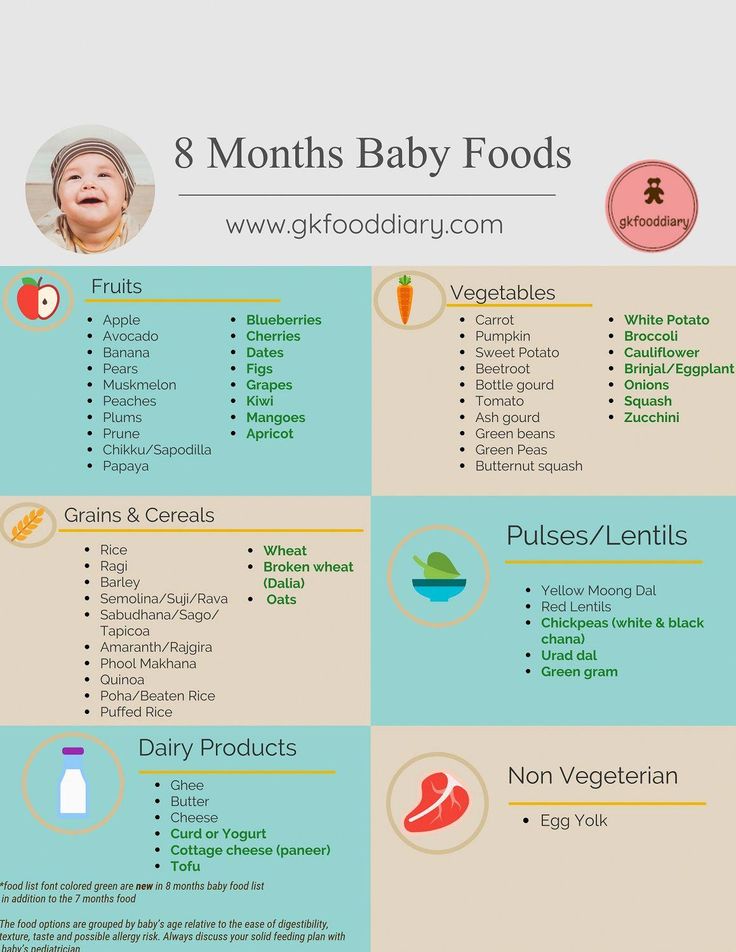 But an early introduction of solids can lead to more colic, digestive troubles and allergies.
But an early introduction of solids can lead to more colic, digestive troubles and allergies.
A baby develops digestive enzymes in between 4 to 6 months which are crucial for digestion of foods. It is a good choice to wait until the baby develops these enzymes completely.
A baby typically begins to develop head control from 3 to 4 months and gains strong head to neck muscles by 6 months. A strong head to neck control helps the baby to accept solids well and can easily swallow.
So by 6 months a baby has a better digestive system and a good head control which are needed before the introduction of solids.
Breast milk is the best bet for the overall growth of a baby. It is recommended to exclusively breast feed a baby for the first 6 months.
As an exception, formula milk is an alternate for women who cannot breast feed baby due to professional, personal or medical reasons.
If you have a baby older than 7 months, you can follow this complete
baby food chart for 8 months old and above
How do you know your baby is ready for solids?
1.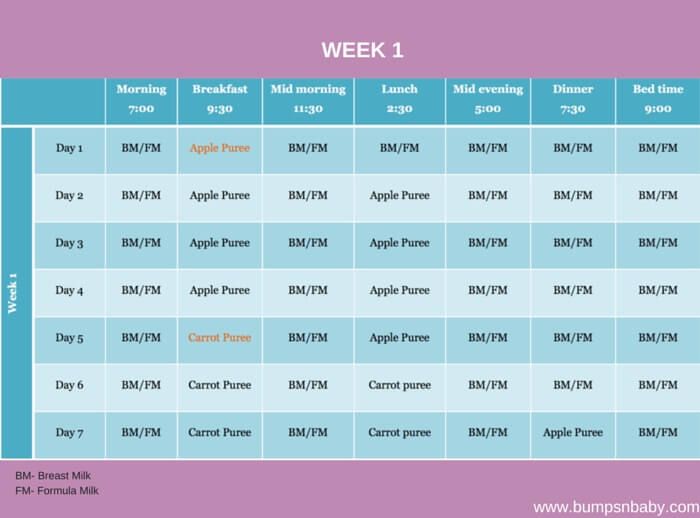 The baby’s head & neck are stable. This means baby can accept food and swallow.
The baby’s head & neck are stable. This means baby can accept food and swallow.
2. Baby must be able to sit stable with or without support.
3. Shows interest in food when others are eating.
4. Baby must be able to open the mouth when food is offered.
5. Baby is still hungry after breastfeeding or formula feed.
Tips on how to start solids for baby
First consult your pediatrician to confirm if your baby is ready for solids. It is very important to plan well before you introduce any other foods apart from breast milk.
Make your own feeding schedule along with the foods you intend you try and get an approval from your pediatrician. Most clinics and hospitals also provide a diet chart or at least a guide.
I have made this from the guidelines I got from the Clinics here in Singapore. I have followed the same for both my babies.
1. Always start with a single food. Either a fruit, vegetable or grain. Avoid a mixture of foods. You can start with mashed fruit first. The presence of digestive enzymes in fruits helps the baby to digest them better.
You can start with mashed fruit first. The presence of digestive enzymes in fruits helps the baby to digest them better.
2. After a week, while you continue feeding fruit, you can start rice water (kanji), after a week clear dal soup or boiled vegetable broth / water.
3. Always follow the 3 day wait rule for every food you introduce. Wait for the results until the 4th day. Please see the doctor immediately if your baby develops rashes, runny nose, watery eyes, colic etc.
4. Introduce new foods to your baby during breakfast or lunch. Avoid trying new foods during the later time of the day as it is easy to get a control over the problems.
5. A 7 month old baby can eat only a tsp of mashed food initially. Slowly by 4 weeks increase the quantity to a tbsp and then more.
Helpful tips – introducing solids for baby
1. Use stainless steel or glass bowls and cups for preparation of baby foods. Avoid plastic ware even made of any superior material, including virgin plastic or graded as BPA free.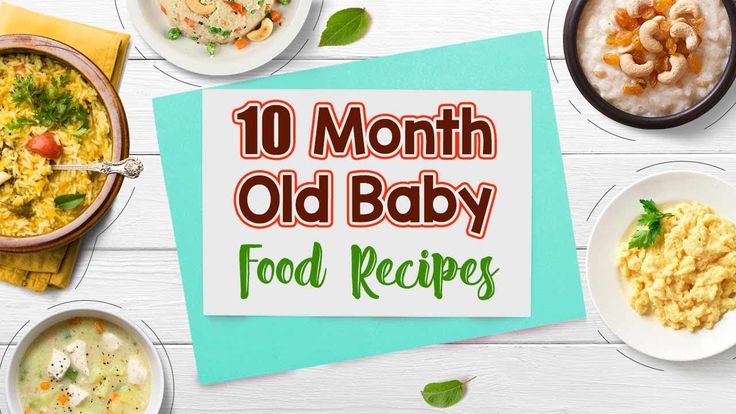 Any kind of plastic ware consists of plasticizers that are used to make the containers flexible.
Any kind of plastic ware consists of plasticizers that are used to make the containers flexible.
Plasticizers are similar to BPA and are an endocrine disruptor. Even BPA free plastic and virgin plastic ware have chemical plasticizers. Please use google search for more info.
2. Always feed the baby in a calm, quite environment and in a steady place like – on the lap, in a high chair or on the floor.
3. While feeding, refrain the baby from activities like watching a TV show, playing with a hand held gadget like mobile, and tablet or game devices. Some of these emit radiation that is not good for the baby.
4. Meal time has to be a learning for the baby, speaking to your baby about the food – its texture, taste and color helps the baby to develop a liking for the food. Or narrate a good story to the baby, do not encourage the baby to talk while eating. This may seem to be over disciplined but this is the only way i have found to grow fuss free kids. They will begin to love any food that is served.
5. Introduce water from a steel cup or a glass not from a feeding bottle or sipper. A 90 ml cup is best suited. This makes the transition from teat to cup easy when the baby grows up.
6 months baby food chart
To follow this baby chart please ensure your baby has completed 6 months and you have an approval from your pediatrician for the same.
A baby usually consumes milk every 2 to 3 hours. Solids should be served in between the feeds. Use plain boiled and cooled water to puree the fruits if needed. Avoid mixing milk or any other ingredient with fruit.
The combination of fruit and milk products results in indigestion, loss of appetite, no weight gain and accumulation of toxins.
Clear soups can be used to make pureed rice, oats or ragi cereal. Feeding only clear soups regularly is not a good idea as they lack the nutrition that is provided by a semi solid food or milk.
I have shared a sample baby food chart below which shows the quantities of fruits and vegetables. From the chart (day 13 to day 20), you can replace potato with rice porridge (kanji) or dal soup or ragi porridge.
From the chart (day 13 to day 20), you can replace potato with rice porridge (kanji) or dal soup or ragi porridge.
This is an alternate table which you can follow if your baby is in between 6 and 7 months.
| Breastfeed or formula milk. What ever time your baby wakes up. |
7.30 to 8 am fruit puree |
| One of the following: (only after 1½ to 2 hours of milk). You can use boiled cooled water to thin down the puree. 1. Banana- mash with a fork or run in a blender. 2. Apple- peel,core,steam for about 5 to 6 minutes. Puree in a blender 3. Chickoo (sapota)- mash with a fork and spoon 4. Pear- peel and core, steam for 5 to 6 minutes 5. Papaya – mash with a fork or blend 6. Ripe avocado – add it to a blender and puree |
11.30 to 12.30 pm |
After introducing fruits, you can try these. Continue to feed fruits for breakfast. Continue to feed fruits for breakfast.first 1 week – rice cereal 2nd week apple rice or rice cereal with boiled carrot 3rd week ragi porridge Or apple ragi or oats porridge Or apple oats Or clear moong dal soup 4th week – Repeat the foods mentioned above. You can also introduce soupy khichdi. You will have to make it following the same method I mentioned for rice cereal above. |
| Breast feed or formula (only after 1.5 to 2 hours of lunch) |
Baby food recipes for 6 months old along with ingredients and instructions to prepare
These are the quantities i followed for my kids i got from the Health Promotion Board,Singapore.Use any one
Quantity of fruits for 6 months to 9 months
½ small apple
½ small pear
½ cup sapota
½ cup papaya
½ medium banana
How many times can the same fruit be given in a week?
Including a variety of fruits will provide different kinds of nutrients to the baby.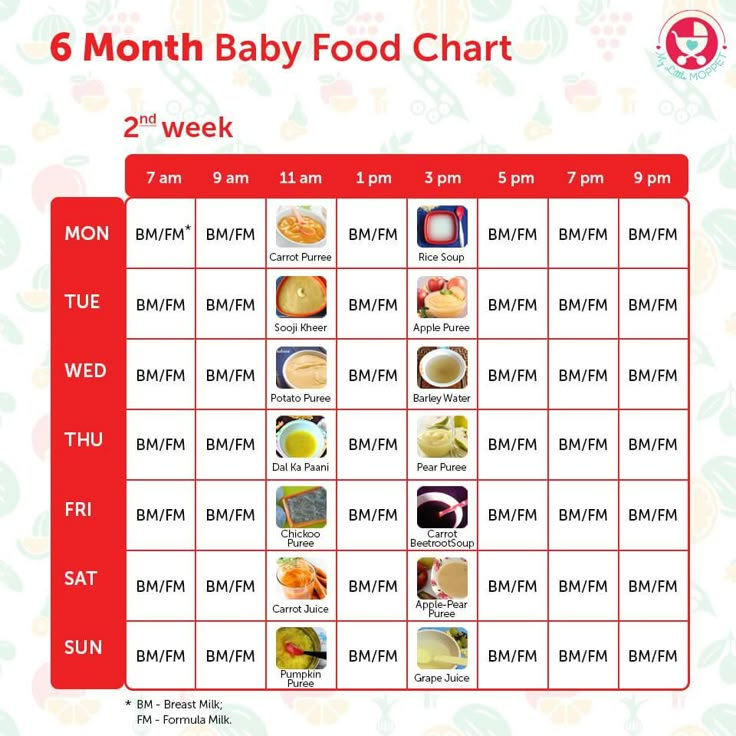
Banana – 3 to 4 times
Apple – daily
Chickoo- daily
Pear- 3 to 4 times
Papaya – 4 to 5 times
Avocado- 3 to 4 times or daily
Do read the complete post before you attempt any of these recipes
More tips on preparing Lunch
from 3 rd week – Rice, ragi or oats. Clear dal soup with veggie.
first 7 days (from 3rd week) -Single grain with milk (formula or breast milk). You can also use gluten free or baby oats or ragi to make porridge.
next 7 days – Rice with a single veggie or apple. You can use steamed or boiled carrots.
VEGETABLES to prefer
1. carrots
2. pumpkin
LENTIL/ DAL to prefer
1. moong dal
2. toor dal
About Swasthi
I’m Swasthi Shreekanth, the recipe developer, food photographer & food writer behind Swasthi’s Recipes. My aim is to help you cook great Indian food with my time-tested recipes. After 2 decades of experience in practical Indian cooking I started this blog to help people cook better & more often at home. Whether you are a novice or an experienced cook I am sure Swasthi’s Recipes will assist you to enhance your cooking skills.
Whether you are a novice or an experienced cook I am sure Swasthi’s Recipes will assist you to enhance your cooking skills.
Follow Swasthi’s Recipes
Email sign up to receive awesome Swasthi’s Recipes in your inbox *
Popular Recipes
Featured Recipes
diet for a 6-month-old baby with breast and artificial feeding, an approximate menu for a week in the table, a diet for a day
Published: 02/10/2021
Reading time: 4 min.
Number of reads: 234524
Author of the article: Ponomareva Yuliya Vladimirovna
Pediatrician, Candidate of Medical Sciences, allergist-immunologist
Changes in a child in the first year of life are very rapid, and every month is not like another. The 6-month milestone is very important, it is largely evaluative and transitional. By this age, most babies have doubled their birth weight, are about 15 cm tall, and some babies have already erupted their teeth. The age of 6 months is also transitional in terms of nutrition. Breast milk or an adapted formula is still the basis of the diet, but with the beginning of the second half of life, all children, without exception, should begin to receive complementary foods. Despite the general graph of growth and weight gain and indicators of psychomotor development, the status and diet of children at 6 months can be very different.
By this age, most babies have doubled their birth weight, are about 15 cm tall, and some babies have already erupted their teeth. The age of 6 months is also transitional in terms of nutrition. Breast milk or an adapted formula is still the basis of the diet, but with the beginning of the second half of life, all children, without exception, should begin to receive complementary foods. Despite the general graph of growth and weight gain and indicators of psychomotor development, the status and diet of children at 6 months can be very different.
Contents: Hide
- First food at 6 months
- Start of weaning at 4-5 months
- Second six months of life
- Sample weekly menu for a baby at 6 months
First food at 6 months
If the baby is healthy and breastfed, and his mother eats a full and varied diet, exclusive breastfeeding is possible until this age. Cereal complementary foods in this case are preferable to start. This is due to the high energy and nutritional value of cereals, the ability to significantly enrich the baby's diet with a delayed start of the introduction of complementary foods.
However, the rate of expansion of the child's diet in this situation will be accelerated. Before the 8th month of life, it is necessary to introduce all basic food groups into the baby’s menu, since in the second half of the year the need for additional intake of nutrients and micronutrients is very high. Another reason explaining the importance of the rapid introduction of complementary foods is the formation of immunity of the immune cells of the intestine to ordinary food. If a child is introduced to these foods at the age of 4-8 months, the risk of developing food allergies has been proven to be reduced.
Complementary feeding starts at 4-5 months
In today's life, the nutrition of a nursing mother, unfortunately, is not always complete. Therefore, for most breastfed babies, complementary foods already need to be introduced from 5 months in order to prevent deficient conditions.
If a child is bottle-fed, then by the 4th month of life, the baby will not have enough adapted formula alone, and in this group of children, the timing of the introduction of complementary foods usually shifts a month earlier than in breast-fed babies. Accordingly, by 6 months, children will have vegetable puree and gluten-free porridge (buckwheat, corn and rice) in their diet. In the first half of life, monocomponent meals are used (that is, from one type of grain and vegetables), prepared on the basis of water, breast milk or an adapted mixture.
Accordingly, by 6 months, children will have vegetable puree and gluten-free porridge (buckwheat, corn and rice) in their diet. In the first half of life, monocomponent meals are used (that is, from one type of grain and vegetables), prepared on the basis of water, breast milk or an adapted mixture.
Fruit puree and juice can be another possible complementary food for children under 6 months of age without allergy symptoms. In a child with a risk of developing or manifesting allergies, the timing of the introduction of fruit complementary foods is shifted to the 8th month.
Second six months of life
Children over 6 months of age can supplement their diet with cereals containing gluten. First of all, these are oatmeal and wheat porridge, and then multi-cereal dishes with the addition of other cereals (millet, barley, rye). If the child does not have any manifestations of allergies, milk porridge can be included in the menu at this age. Bebi Premium industrial baby food products include specially prepared milk that is safe to use in healthy babies in the first year of life.
From the age of 6 months, the baby's diet is expanded with such important products as meat and cottage cheese. These products are a source of high-quality protein, fats, and are also rich in minerals such as iron, calcium, and phosphorus. Pediatricians and nutritionists recommend introducing meat and cottage cheese as part of combined dishes based on a fruit and vegetable and / or grain component in a ratio of 1 (cottage cheese / meat): 4–5 (fruits / vegetables / cereals).
To enrich the diet with polyunsaturated fatty acids in the second half of the year, the menu includes vegetable oil in the amount of 3–5 grams per day, which can be added to the complementary food dish. The volume of each feeding is approximately 150-170 ml, and the child can already stand up to 3.5 hours between meals.
In the table below, we offer a menu of 6 months for a week for a child who started receiving complementary foods at the age of 4-5 months, and by the time the second half of life begins, dairy-free gluten-free cereals, vegetable and fruit purees have already been introduced into his diet.
Day 1
| meal | menu | ml/g |
| Early morning | infant formula 065 150 | 100 |
| 9 | 50 | |
| Apple juice | 60 | |
| 12.30 | Courgette puree, olive oil | 100/3 |
| Turkey puree | 30 | |
| Compote | 50 | |
| Breast milk/formula | 150 | |
| 19.30 | Pear puree with cottage cheese | 60/30 |
| Baby instant biscuits "Bebiki" classic | 20 | |
| Bebi Premium Baby Instant Herbal Tea | 50 | |
| Bedtime | Breast milk/formula | 071|
Day 2
| meal | menu | ml/g | |
| Early morning | Breastmilk/formula | 150 | |
09. 00 00 | Bebi Premium Active Day Milk Oatmeal | 100 | |
| 0081 | |||
| Bebi Premium baby drinking water | 50 | ||
| 12.30 | Carrot puree, corn oil | 70/3 | |
| Veal puree | 30 | ||
| Dried fruit compote | 50 | ||
| Afternoon milk porridge with biscuits, cherries and apples Bebi Premium | 100 | ||
| Breast milk/formula | 50 | ||
| 20.00 | Apple-pumpkin puree with cottage cheese 9Bebi Premium Instant Herbal Tea 0065 Breast milk/formula | 150 | |
Day 3
| meals | menu | ml/g | |
| Early morning | Breast milk/formula | 150 | |
09. 00 00 | Wheat milk porridge with apple and banana Bebi Premium | 100 | 6 |
| 50 | |||
| Apple juice | 60 | ||
| 12.30 | Milk Rice Porridge with Pumpkin and Apple Delicious Bebi Premium Lunch | 100 | |
| Compote cottage cheese | 60/30 | ||
| Baby instant biscuits "Bebiki" classic | 20 | ||
| Breast milk/formula | 500065 Mashed Potato, Olive Oil | 60/3 | |
| Mashed Rabbit | 30 | ||
| Instant Baby Herbal Tea | bi Premium | 50 | |
| Before bed | Breast milk/formula | 150 | |
Day 4
| meal | 9Breakfast 066Milk buckwheat porridge with dried apricots and apple Bebi Premium | 100 | |||
Lunch (12.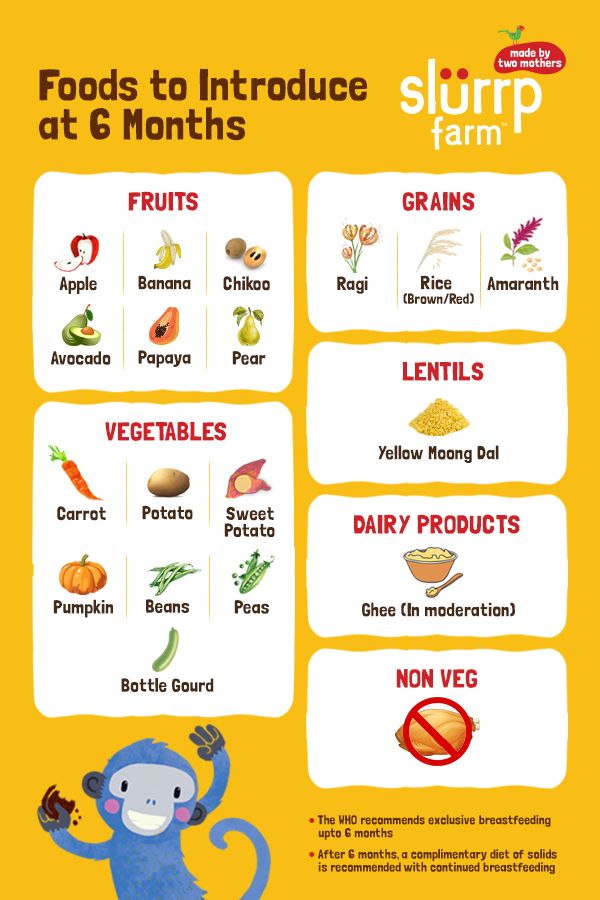 30) 30) | Vegetable soup with beef and olive oil | 100/30/3 | Dried fruit compote | 50 | |
| Afternoon snack (16.00) | Plum puree with cottage cheese | 60/40 | |||
| Breast milk/formula | 60 081 | ||||
| Dinner (19.30) | Milk night porridge 3 cereals with apple and chamomile Bebi Premium | 100 | |||
| Instant herbal tea Bebi5 Children's instant tea Premium | 50 | ||||
| Before bed | Breast milk/formula | 150 | |||
Day 5Breakfast 066
 30)
30) day 6 0062
 00)
00) Day 7
| meal | menu | ml/g | ||
| 150 | ||||
Breakfast (09. 00) 00) | Milk porridge "Bebi Premium fruit and cereal assortment" | 100 | ||
| Breast milk/formula | 50 | |||
| Apple Plum Juice | 60 | |||
| Vegetable stew, corn oil | 80/2 | |||
| veal | 40 | |||
| Dried fruit compote | 50 | |||
| 6 | Breastmilk/formula | 150 | ||
| Baby instant biscuits "Bebiki" classic | 20 | |||
| 5 Dinner (19.30) | Pear puree with rice and cottage cheese | 60/30/ 30 | ||
| Bebi Premium Kids Instant Herbal Tea | 50 | |||
| Bedtime 065 Breast milk/formula | 150 | |||
Rate the article
(Number of votes: 23, average 4.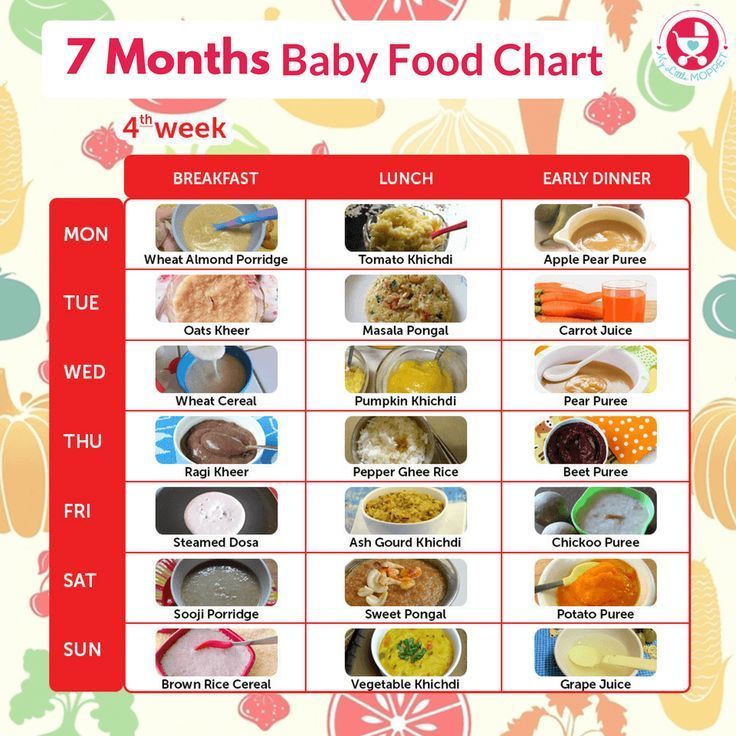 8)
8)
Share with friends:
Diet for a child from 6 months to a year
From 6 to 12 months, your baby develops at an incredible pace. It is during this period that his body needs a sufficient amount of nutrients and trace elements. The right diet will help provide your little one with the necessary nutrients and energize them to explore the world around them and gain new skills! In order to properly build a diet from 6 months old, we have prepared approximate menus for a child, broken down by months, and the feeding table itself from 4 months old can be downloaded here.
Menu at 6 months
Menu at 7 months
Menu at 8 months
Menu at 9 months
Menu at 10 months
Menu at 11 months
Menu at 12 months
Menu at 6 months
At 6 months, the baby's diet contains monocomponent vegetable purees (broccoli, zucchini, cauliflower), 1-2 types of porridge, monocomponent meat puree and children's cottage cheese.
| 6.00 | Breast milk, 200 gr (until saturation) |
| 09:00-09:30 | Dairy-free porridge 10-150 gr (depending on the introduction of complementary foods) + breast milk at the request of the child |
| 13:00-13:30 | Vegetable puree 10-150 gr, meat puree, e.g. Hamé Turkey, 10-30 gr (depending on complementary foods) + breast milk at the request of the child |
| 18:00-18:30 | Cottage cheese 10-40 gr, fruit puree 10-40 gr (depending on the input of complementary foods) + breast milk (until saturation) |
| 21:00-21:30 | Breast milk, 200 gr (until saturation) |
| 00:00 | Breast milk, 200 gr (until saturation) |
Vegetable oil can be added to vegetables and porridge.
Menu at 7 months
By 7 months, the volume of complementary foods increases, new types of meat, vegetables and fruits are introduced. Also in the diet of the child appears yolk.
| 6.00 | Breast milk, 200 gr (until saturation) |
| 09:00-09:30 | Dairy-free porridge 150 gr + breast milk at the request of the child |
| 13:00-14:00 | Vegetable puree 150-170 gr, meat puree, e.g. Hamé Veal, 30 gr, 1/4 egg yolk + breast milk at the request of the child |
| 18:00-18:30 | Fruit and cottage cheese puree 80 gr + breast milk (until saturation) |
| 21:00-21:30 | Breast milk, 200 gr (until saturation) |
| 00:00 | Breast milk, 200 gr (until saturation) |
You can add butter or vegetable oil to vegetables and porridge.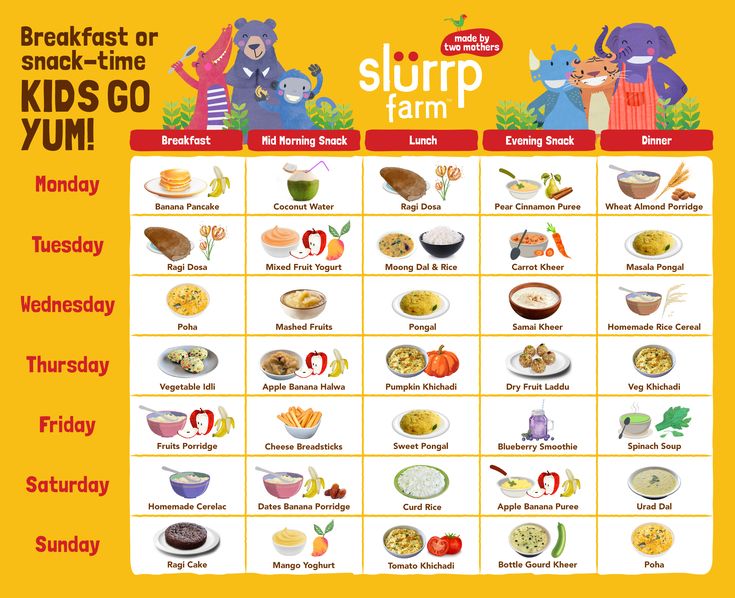
Menu at 8 months
From 8 months you can introduce baby purees with fish and meat purees with the addition of offal. You can also start offering fruit in a nibbler so your little one can scratch their teeth and try new flavors.
| 6.00 | Breast milk, 200 gr (until saturation) |
| 09:00-09:30 | Milk/dairy-free porridge 150 gr, fruit puree 40 gr + breast milk at the request of the child |
| 13:00-14:00 | Vegetable puree 150 gr, meat puree, e.g. Hamé Beef with tongue, 50 gr, 1/2 egg yolk + breast milk on request |
| 18:00-18:30 | Fruit and cottage cheese puree 80 gr + breast milk (until saturation) |
| 21:00-21:30 | Porridge with butter 60 gr + breast milk (until full) |
| 23:30-00:00 | Breast milk, 200 gr (until saturation) |
A more satisfying dinner with the addition of porridge contributes to sound sleep without frequent awakenings for feeding.
Menu at 9months
The daily menu is filled with new types of products from all categories: fish purees, sour-milk products and cereals.
| 6.00 | Breast milk, 200 gr (until saturation) |
| 09:00-09:30 | Milk/dairy-free porridge 150 gr, fruit puree 40 gr + breast milk at the request of the child |
| 13:00-14:00 | Vegetable puree 150 gr, fish or meat puree, e.g. Hamé Chicken, 60 gr, 1/2 egg yolk + breast milk as desired by the child |
| 18:00-18:30 | Fruit and cottage cheese puree 100 gr + breast milk (until saturation) |
| 21:00-21:30 | Porridge with butter 60 gr + breast milk (until full) |
| 23:30-00:00 | Breast milk, 200 gr (until saturation) |
At 9 months, you can enter baby cookies and up to 10 grams of bread.
Menu at 10 months
At this age, the baby’s menu can be slightly diversified with some dishes from the general table: weak broths, cottage cheese puddings or casseroles, vegetables and fruits, grated on a fine grater.
| 6.00 | Breast milk, 200 gr (until saturation) |
| 09:00-09:30 | Milk/dairy-free porridge 150 gr, fruit puree 60 gr + breast milk at the request of the child |
| 13:00-14:00 | Vegetable puree 150 gr, fish or meat puree, e.g. Hamé Beef with heart, 70 gr, 1/2 egg yolk + breast milk as desired by the child |
| 18:00-18:30 | Cottage cheese 50 gr, fruit puree 80 gr + breast milk (until full) |
| 21:00-21:30 | Porridge with butter 60 gr + breast milk (until full) |
| 23:30-00:00 | Breast milk, 200 gr (until saturation) |
During the day, you can offer children's cookies and up to 10 grams of bread.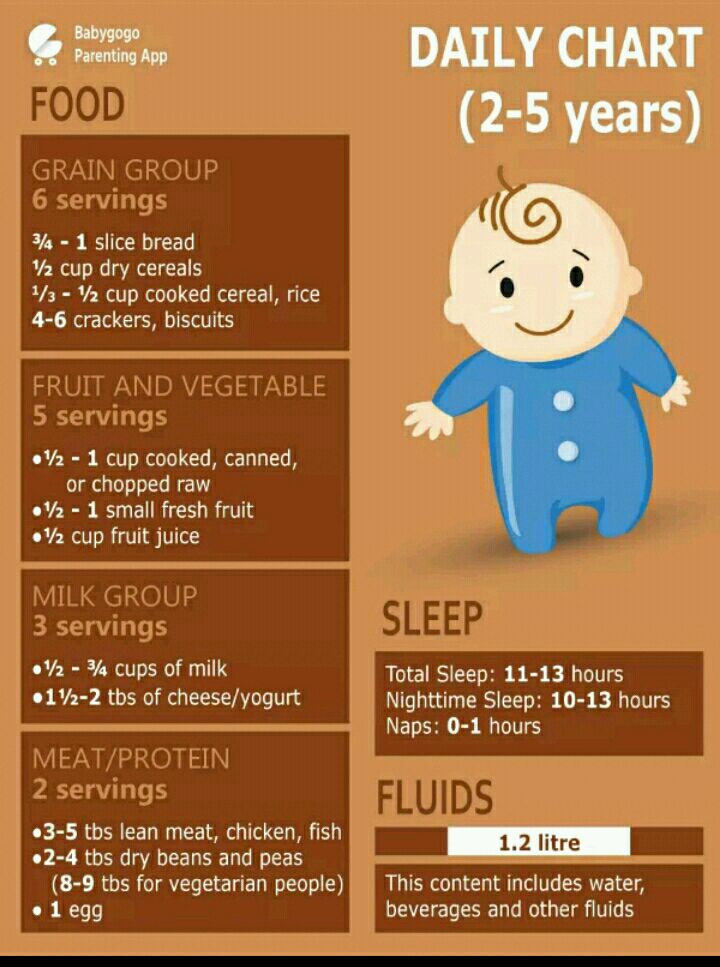
Menu at 11 months
At this age, the baby makes the first attempts to eat on its own. Parents can help by offering chopped soft fruits and vegetables. Steamed meat dishes are also suitable: meatballs, meatballs, fish fillet or finely chopped boiled chicken.
| 6.00 | Breast milk, 200 gr (until saturation) |
| 09:00-09:30 | Milk/dairy-free porridge 150 gr, fruit puree 60 gr + breast milk at the request of the child |
| 13:00-14:00 | Vegetable puree 150 gr, fish or meat puree, e.g. Hamé Beef with liver, 80 gr, 1/2 egg yolk + breast milk on request |
| 18:00-18:30 | Fruit and cottage cheese puree 100 gr + breast milk (until saturation) |
| 21:00-21:30 | Porridge with butter 60 gr + breast milk (until full) |
| 23:30-00:00 | Breast milk, 200 gr (until saturation) |
During the day, you can offer children's cookies and up to 10 grams of bread.



